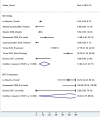Mother-to-child transmission of Chikungunya virus: A systematic review and meta-analysis
- PMID: 29897898
- PMCID: PMC6075784
- DOI: 10.1371/journal.pntd.0006510
Mother-to-child transmission of Chikungunya virus: A systematic review and meta-analysis
Abstract
Background: Chikungunya virus (CHIKV) is an emerging arboviral infection with a global distribution and may cause fetal and neonatal infections after maternal CHIKV-infections during gestation.
Methodology: We performed a systematic review to evaluate the risk for: a) mother-to-child transmission (MTCT), b) antepartum fetal deaths (APFD), c) symptomatic neonatal disease, and d) neonatal deaths from maternal CHIKV-infections during gestation. We also recorded the neonatal clinical manifestations after such maternal infections (qualitative data synthesis). We searched PubMed (last search 3/2017) for articles, of any study design, with any of the above outcomes. We calculated the overall risk of MTCT, APFDs and risk of symptomatic neonatal disease by simple pooling. For endpoints with ≥5 events in more than one study, we also synthesized the data by random-effect-model (REM) meta-analysis.
Principal findings: Among 563 identified articles, 13 articles from 8 cohorts were included in the quantitative data synthesis and 33 articles in the qualitative data synthesis. Most cohorts reported data only on symptomatic rather than on all neonatal infections. By extrapolation also of these data, the overall pooled-MTCT-risk across cohorts was at least 15.5% (206/1331), (12.6% by REMs). The pooled APFD-risk was 1.7% (20/1203); while the risk of CHIKV-confirmed-APFDs was 0.3% (3/1203). Overall, the pooled-risk of symptomatic neonatal disease was 15.3% (203/1331), (11.9% by REMs). The pooled risk of symptomatic disease was 50.0% (23/46) among intrapartum vs 0% (0/712) among antepartum/peripartum maternal infections. Infected newborns, from maternal infections during gestation were either asymptomatic or presented within their first week of life, but not at birth, with fever, irritability, hyperalgesia, diffuse limb edema, rashes and occasionally sepsis-like illness and meningoencephalitis. The pooled-risk of neonatal death was 0.6% (5/832) among maternal infections and 2.8% (5/182) among neonatal infections; long-term neurodevelopmental delays occurred in 50% of symptomatic neonatal infections.
Conclusions/significance: Published cohorts with data on the risk to the fetus and/or newborn from maternal CHIKV-infections during gestation were sparse compared to the number of recently reported CHIKV-infection outbreaks worldwide; however perinatal infections do occur, at high rates during intrapartum period, and can be related to neonatal death and long-term disabilities.
Conflict of interest statement
The authors have declared that no competing interests exist.
Figures



References
-
- Doughty CT, Yawetz S, Lyons J. Emerging Causes of Arbovirus Encephalitis in North America: Powassan, Chikungunya, and Zika Viruses. Curr Neurol Neurosci. 2017;17(2). doi: ARTN 12 10.1007/s11910-017-0724-3. PubMed PMID: WOS:000397031600008. - PubMed
-
- CDC. Centers for Disease Control and Prevention: Chikungunya virus. https://www.cdc.gov/chikungunya/geo/united-states-2016.html.
-
- Olajiga OM, Adesoye OE, Emilolorun AP, Adeyemi AJ, Adeyefa EO, Aderibigbe IA, et al. Chikungunya Virus Seroprevalence and Associated Factors among Hospital Attendees in Two States of Southwest Nigeria: A Preliminary Assessment. Immunol Invest. 2017;46(6):552–65. 10.1080/08820139.2017.1319383 PubMed PMID: WOS:000406546400003. - DOI - PubMed
Publication types
MeSH terms
Grants and funding
LinkOut - more resources
Full Text Sources
Other Literature Sources
Medical

